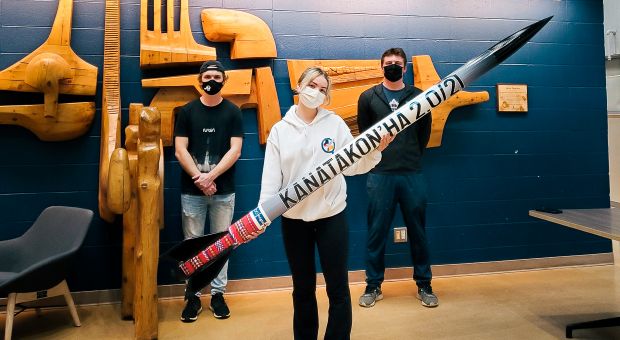When the seven-member First Nations Launch team of Indigenous engineering students at Queen’s found themselves without access to a proper rocket launch site late last term—and when COVID restrictions barred them from travel to the United States to participate in the competition in person—they had to improvise.
A competing team in California offered their launch site and via live stream the Queen’s team was able to guide the setup and launch of their rocket.
First Nations Launch is an annual competition hosted by NASA exclusive to Indigenous students. In 2019, the Queen’s team became the first outside the United States to participate. A multistep competition, the team had to present their adapted rocket designs throughout the fall and winter terms.
The Queen’s team consists of Maranda Cherry, Cameron Bishop, Jeffrey McCaw, Spencer Bundy, Tyler Cowie, Eric Birchall, and John Sekijoba.

In the runup to the competition, the team ran into significant COVID restrictions locally amid the design and construction of its rocket.
“We had to have a supervisor present at all times and we could only have three members present at any one time,” said Cherry, a third-year Engineering Physics student, regarding their limited on-campus visits. “We weren’t able to get permission to begin construction on our rocket until March. The competition was in April, and we launched in May. So we really had two months to build a rocket that we’d been designing all year.” And because there is no standard shipping box that would accommodate the rocket, the team had to design and package it as well.
“The process of First Nations Launch was presentations and reports throughout the year,” said Cherry, “and then the launch itself.”
The year’s worth of work all culminated in the “proxy launch” which took place near the University of California, Davis campus and was performed by the UC Davis team on their behalf.
“The day of the launch my team and I sat on a four-hour Zoom call,” she said, “with the UC Davis team working on assembling the rocket and troubleshooting. We were there with them the entire time, and then we got to see it launch! Our rocket went a total of 4,133 feet in the air, and it hit Mach 0.5 which is half the speed of sound.” By all accounts it was a success.
As a NASA sponsored event—NASA being a United States government agency—the Queen’s team wasn’t technically eligible to receive any rewards of the competition and, though it placed first in a new “international” category, a review of the points that each team had accumulated across the year revealed that the Queen’s team ranked second overall.
“On top of that, we won two category awards,” said Cherry. “The aesthetic award for our rocket and also the written report award.”


